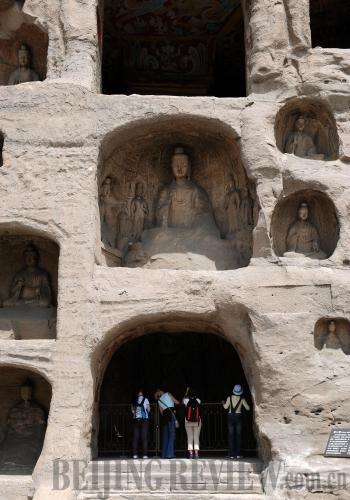|
 |
|
NEW LOOK: All institutions and commercial operations considered by experts harmful to the protection of the Yungang Grottoes in Datong, Shanxi Province, have been removed from the core scenic area (XINHUA) |
Since the first batch of cultural and natural sites of China were inscribed on the UNESCO world heritage list in 1987, China now has 40 listed sites, ranking third in the world in terms of the number of listed sites.
Though none of China's world heritages have been listed as an endangered site, or any face the danger of being excluded, there is still a great deal that could be done for China to improve its heritage preservation, said Guan Qiang, Director of the Department of Cultural Relics Protection and Archaeology of State Administration of Cultural Heritage (SACH), at a meeting in Beijing on world heritage monitoring work held on May 19-20 this year.
At the meeting, delegates from world heritage sites, such as the Mogao Caves in Dunhuang, Gansu Province, the classical gardens of Suzhou, Jiangsu Province, the Summer Palace and the Peking Man Site at Zhoukoudian in Beijing, reported on monitoring and protection work.
Monitoring system
The reporting mechanism on monitoring work is a measure taken in response to a system launched by the World Heritage Committee in 1994. It includes regular inspection, discussion and assessment of the state of preservation of world heritage sites and carrying out reactive monitoring.
In 2006, the Chinese Ministry of Culture set down Measures for Protection and Management of World Cultural Heritages. Since then, the country has established a monitoring system to protect heritage sites in China. If a site's value, authenticity and integrity are threatened because of inadequate protection, it is added to a warning list released by the SACH. In December 2006, the SACH promulgated measures to monitor and manage China's world cultural heritage sites—specifying procedures, responsibilities and range—to standardize the monitoring work.
During the 31st session of the World Heritage Committee in 2007, the ancient town of Lijiang, Yunnan Province, received inquiries from the World Heritage Committee about whether the city would be capable of balancing protection and social development or even overdevelopment.
Economic concern
Lijiang was listed as a world cultural heritage in 1997 and has since become well-known to the world. Within 10 years, the population of people of the Naxi ethnic group living in Lijiang decreased to a few thousand from 40,000. Most aboriginal residents moved out of the ancient town, replaced by tens of thousands of tourists. Many shopkeepers on commercial streets now have non-local accents. In the evening, red lanterns and bars full of people made visitors feel as if they are in a bustling city.
|
